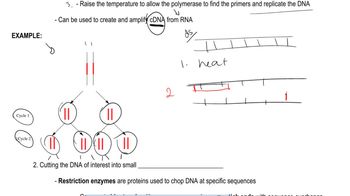As a genetic counselor, you are asked to assess the risk for a couple with a family history of familial adenomatous polyposis (FAP) who are thinking about having children. Neither the husband nor the wife has colorectal cancer, but the husband has a sister with FAP. What is the probability that this couple will have a child with FAP? Are there any tests that you could recommend to help in this assessment?
Table of contents
- 1. Introduction to Genetics51m
- 2. Mendel's Laws of Inheritance3h 37m
- 3. Extensions to Mendelian Inheritance2h 41m
- 4. Genetic Mapping and Linkage2h 28m
- 5. Genetics of Bacteria and Viruses1h 21m
- 6. Chromosomal Variation1h 48m
- 7. DNA and Chromosome Structure56m
- 8. DNA Replication1h 10m
- 9. Mitosis and Meiosis1h 34m
- 10. Transcription1h 0m
- 11. Translation58m
- 12. Gene Regulation in Prokaryotes1h 19m
- 13. Gene Regulation in Eukaryotes44m
- 14. Genetic Control of Development44m
- 15. Genomes and Genomics1h 50m
- 16. Transposable Elements47m
- 17. Mutation, Repair, and Recombination1h 6m
- 18. Molecular Genetic Tools19m
- 19. Cancer Genetics29m
- 20. Quantitative Genetics1h 26m
- 21. Population Genetics50m
- 22. Evolutionary Genetics29m
19. Cancer Genetics
Overview of Cancer
Problem C.11d
Textbook Question
Go to the website http://www.ncbi.nlm.nih.gov/omim and enter 'Lynch syndrome' in the Search box at the top of the page. From the list of options given, select '#120435—Lynch Syndrome.' Use the information you retrieve to answer the following questions. What are the approximate rates of cancer that develop in people carrying a mutation of one of these genes?
 Verified step by step guidance
Verified step by step guidance1
Understand that Lynch syndrome is a hereditary condition caused by mutations in mismatch repair genes, which significantly increase the risk of certain cancers, especially colorectal and endometrial cancers.
Navigate to the NCBI OMIM website and enter 'Lynch syndrome' in the search box to find detailed genetic and clinical information about the syndrome.
Select the entry '#120435—Lynch Syndrome' to access comprehensive data, including gene mutations involved and associated cancer risks.
Locate the section within the OMIM entry that discusses cancer risks or penetrance, which typically provides approximate percentages or rates of cancer development in mutation carriers.
Interpret the data by noting the approximate lifetime risk percentages for different types of cancers (e.g., colorectal, endometrial) in individuals with Lynch syndrome gene mutations, understanding that these rates reflect increased susceptibility compared to the general population.
 Verified video answer for a similar problem:
Verified video answer for a similar problem:This video solution was recommended by our tutors as helpful for the problem above
Video duration:
2mPlay a video:
Was this helpful?
Key Concepts
Here are the essential concepts you must grasp in order to answer the question correctly.
Lynch Syndrome and Its Genetic Basis
Lynch syndrome is an inherited disorder caused by mutations in DNA mismatch repair genes, such as MLH1, MSH2, MSH6, and PMS2. These mutations increase the risk of developing certain cancers, especially colorectal and endometrial cancers, by impairing the cell's ability to correct DNA replication errors.
Recommended video:
Guided course

Genetic Cloning
Cancer Penetrance in Mutation Carriers
Penetrance refers to the proportion of individuals with a specific genetic mutation who exhibit the associated disease. In Lynch syndrome, penetrance is expressed as the approximate lifetime risk or rate of developing cancer among mutation carriers, which varies depending on the gene mutated and other factors.
Recommended video:
Guided course

Cancer Mutations
Using OMIM Database for Genetic Information
OMIM (Online Mendelian Inheritance in Man) is a comprehensive database cataloging human genes and genetic disorders. It provides detailed information on gene mutations, associated phenotypes, and epidemiological data, such as cancer risk rates in Lynch syndrome, enabling researchers and students to access reliable genetic information.
Recommended video:
Guided course

Modern Genetics

 9:51m
9:51mWatch next
Master Cancer Characteristics with a bite sized video explanation from Kylia
Start learningRelated Videos
Related Practice
Textbook Question
600
views
